Distributors/Service Centers

August 18, 2017
Service Center Shipments Dip in July
Written by Peter Wright
Service center shipments took the normal dip in July, but the decline was slightly more than the historical average. Months on hand at the end of July were up sharply, partly because of a decline in shipping days, according to Steel Market Update’s latest analysis of Metals Service Center Institute data.
Daily shipments in July were 5.1 percent lower than in June. On average since 2009, July has decreased by 4.6 percent, therefore these latest numbers were a little worse than normal for this time of year. Carbon steel shipments were 140,600 tons per day in July and months on hand on the 31st were 2.51, up from 2.09 at the end of June.
Intake and Shipments
In July, total carbon steel intake at 153,400 tons per day (t/d) was 12,800 tons more than shipments. This was the second month of surplus after three months of deficit. Total sheet products had an intake surplus of 8,900 tons; this was the third month of surplus after three successive months of deficit.
Total daily carbon steel shipments decreased from 148,000 tons in June to 140,600 tons in July. MSCI data is quite seasonal, and we need to eliminate that effect before commenting in detail on an individual month’s result. Figure 1 demonstrates this seasonality and why comparing a month’s performance with the previous month can be misleading, particularly in July and the fourth quarter of the year.
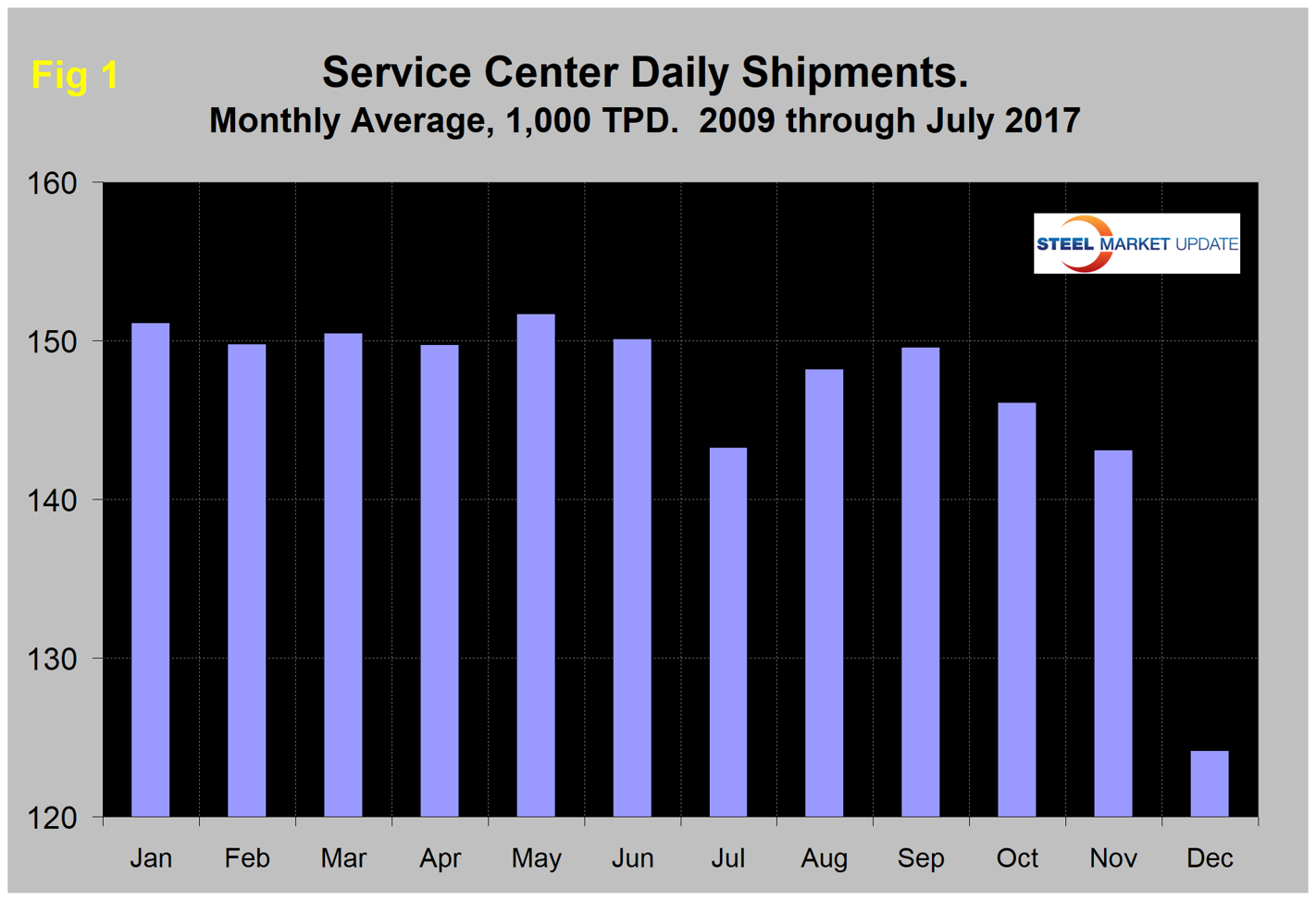
We can expect shipments to bounce back by about 3.5 percent in August. In the analysis described below, we report year-over-year changes to eliminate seasonality. Our intention is to provide an undistorted view of market direction.
Table 1 shows the performance by product in July compared to the same month last year. It also shows the average daily shipments for this and the two previous months of July. We then calculate the percent change between July 2017 and July 2016 and with the most recent three-year July average.
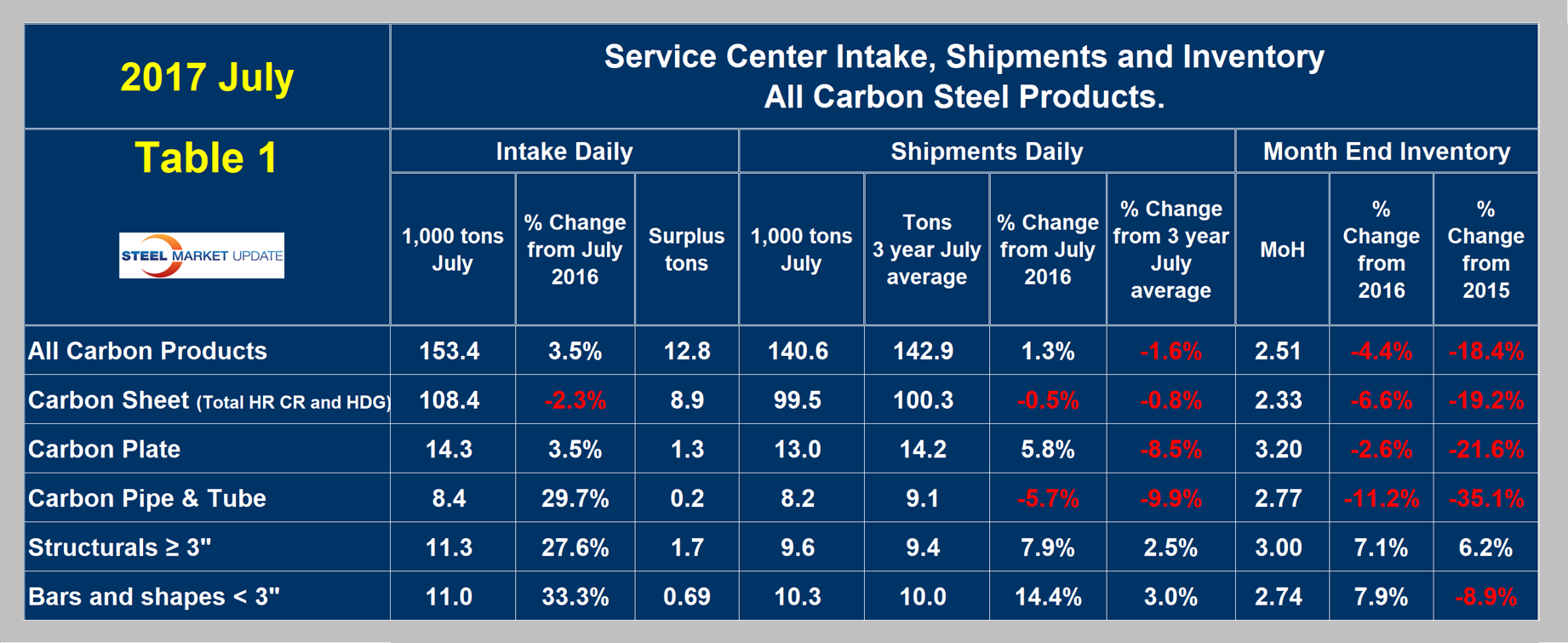
July this year was up by 1.3 percent from July 2016, but down by 1.6 percent from the three-year July average. The fact that the y/y growth comparison is better than the three-year comparison suggests that momentum is positive. Shipments of plate and long products were up from July last year, but sheet and tubulars were down. This was the same pattern we observed in the June data.
Figure 2 shows the long-term trend of daily carbon steel shipments since 2000 as three-month moving averages.
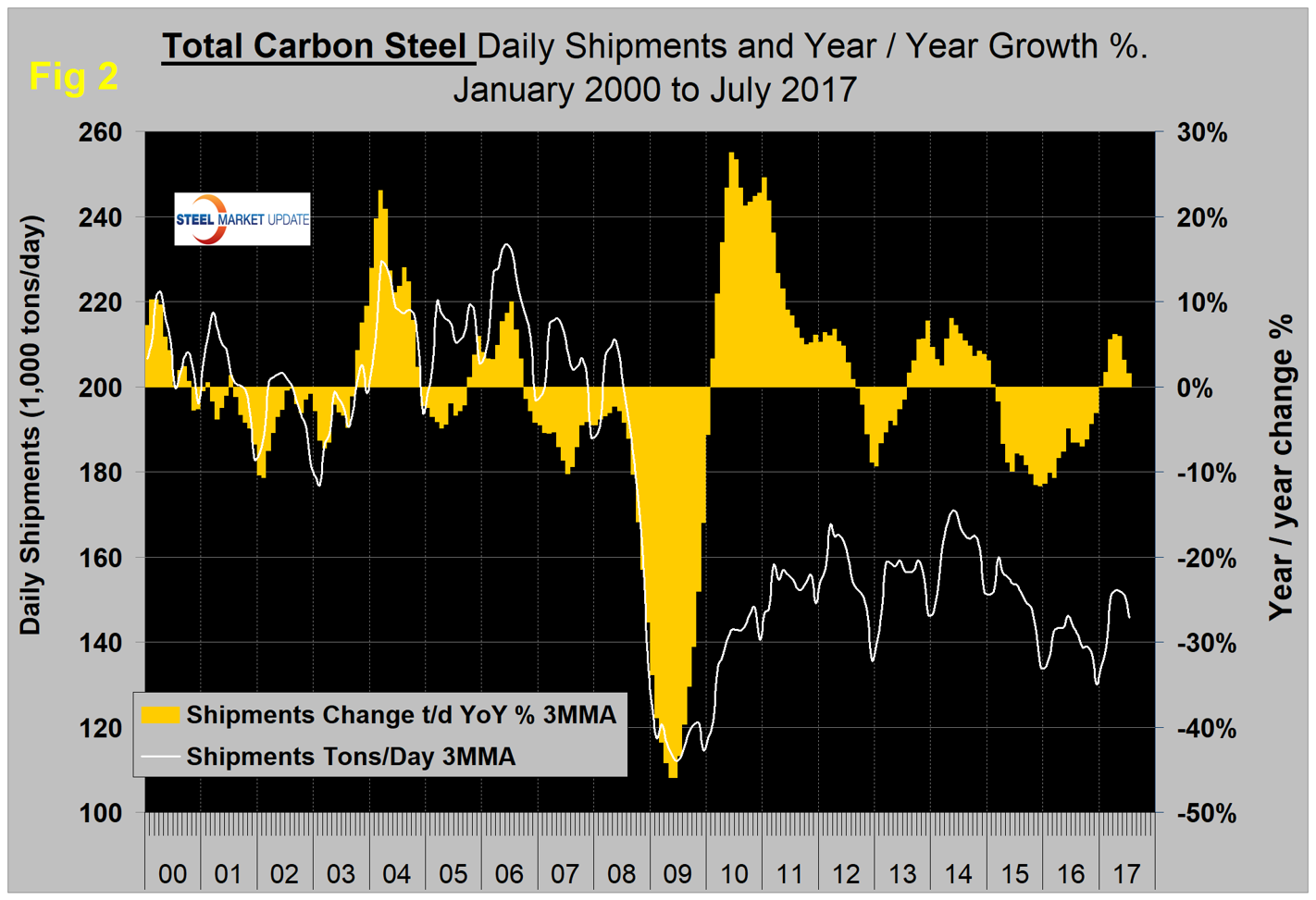
(In our opinion, the quickest way to size up the market is the brown bars in Figures 2, 3, 4, 5 and 6, which show the percentage y/y change in shipments by product.) In January, on a 3MMA basis, there was positive y/y growth of 0.07 percent, which improved to 6.2 percent in April before declining to positive 1.6 percent in July. These were the first positive y/y results since July 2015.
Figure 3 shows monthly long product shipments from service centers as a 3MMA with y/y change.
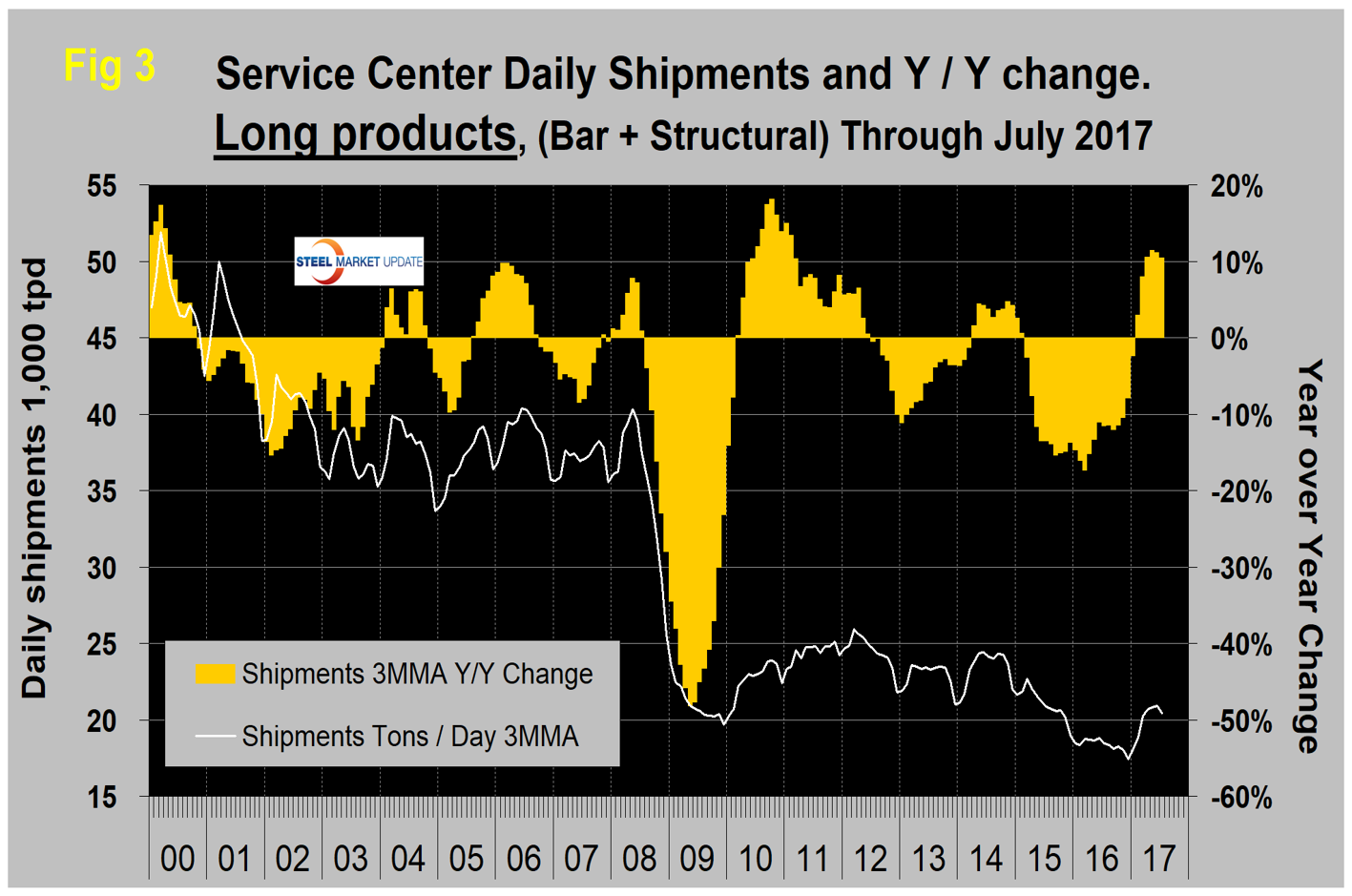
Growth has improved this year and is now the highest it has been since early 2011. The four months through July all exceeded a 10 percent y/y growth rate. Figures 4, 5 and 6 show the 3MMA of daily shipments and the y/y growth for sheet, plate and tubular goods, respectively.
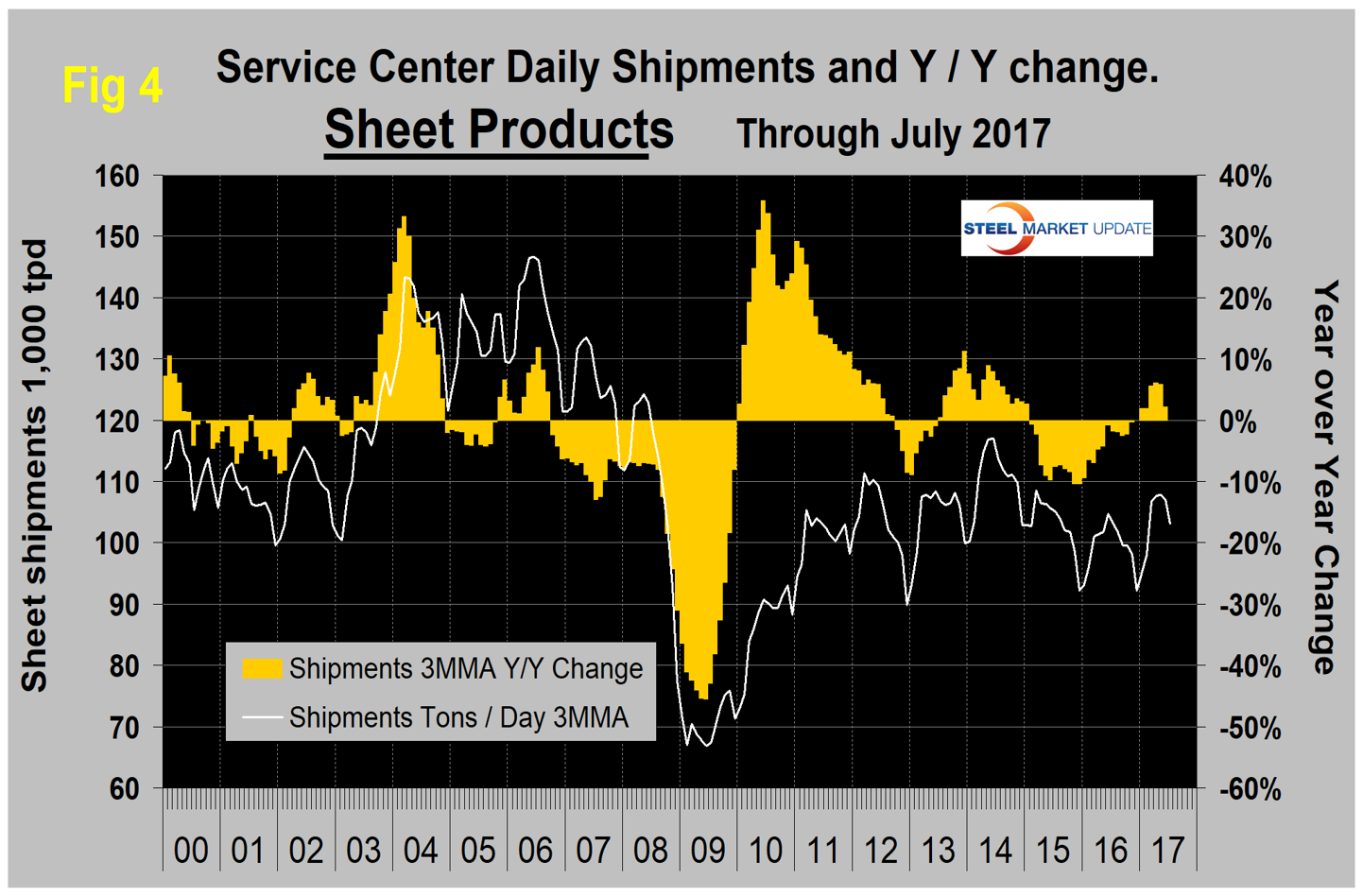
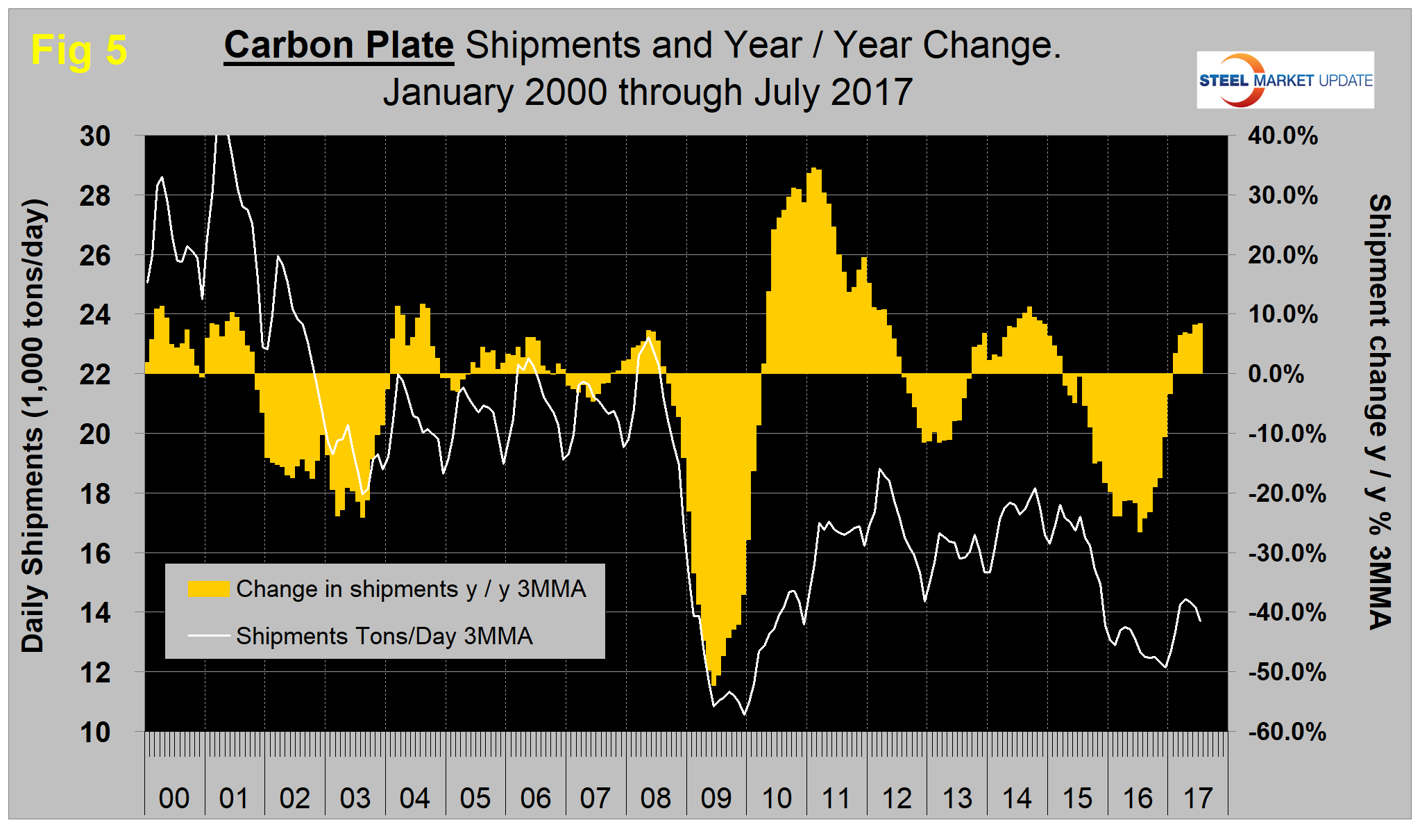
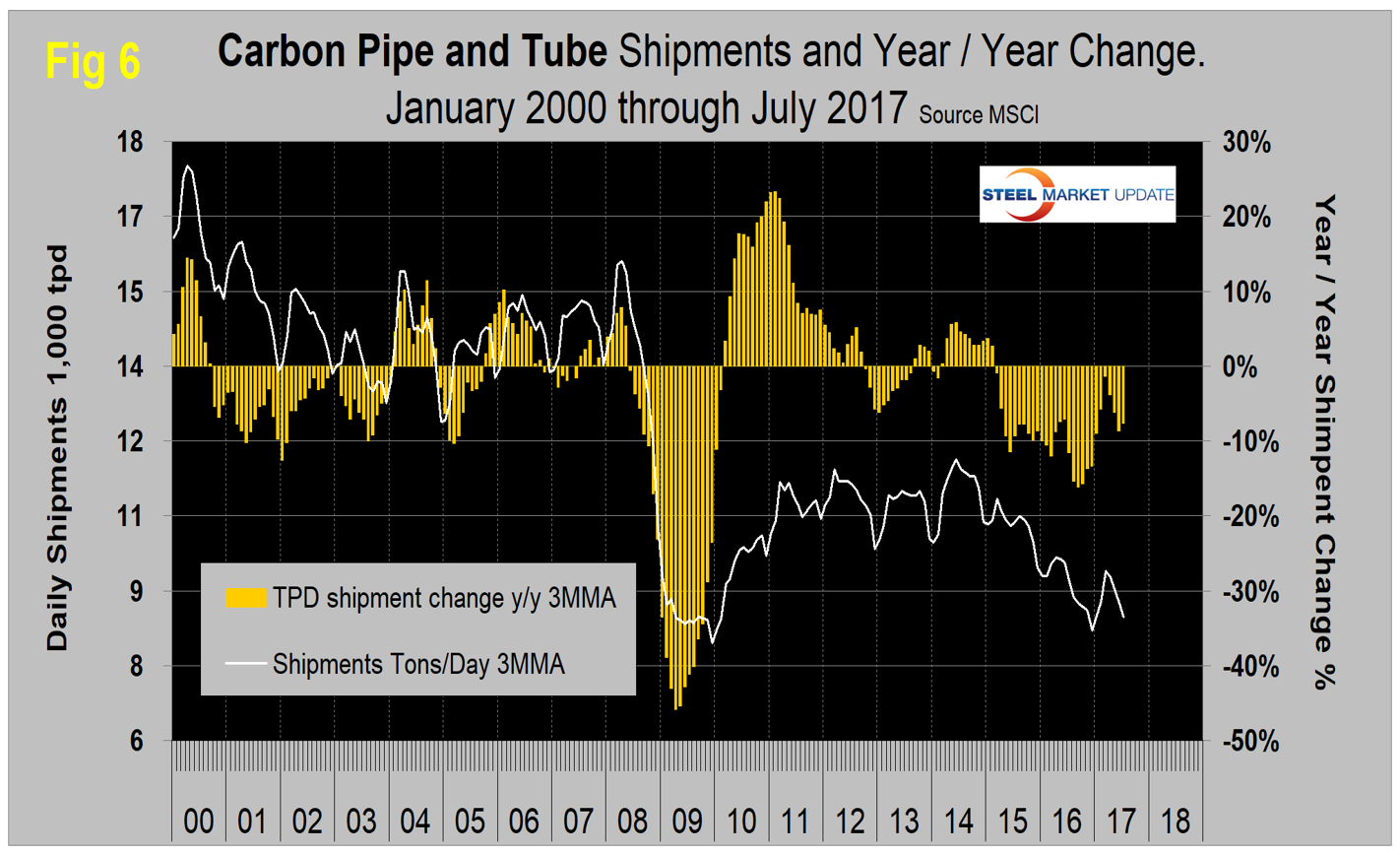 Plate performed much worse than sheet in 2015 and 2016. This year, plate has begun to close the gap. Pipe and tube have performed very poorly since early 2015, which exactly coincides with the decline in rig count. The rig count has been recovering for a year now, but so far this has not translated into improved shipments of pipe and tube from service centers.
Plate performed much worse than sheet in 2015 and 2016. This year, plate has begun to close the gap. Pipe and tube have performed very poorly since early 2015, which exactly coincides with the decline in rig count. The rig count has been recovering for a year now, but so far this has not translated into improved shipments of pipe and tube from service centers.
In 2006 and 2007, the mills and service centers were operating at maximum capacity. Figure 7 takes the monthly shipments by product and indexes them to the average for 2006 and 2007 to measure the extent to which shipments of each product have recovered.
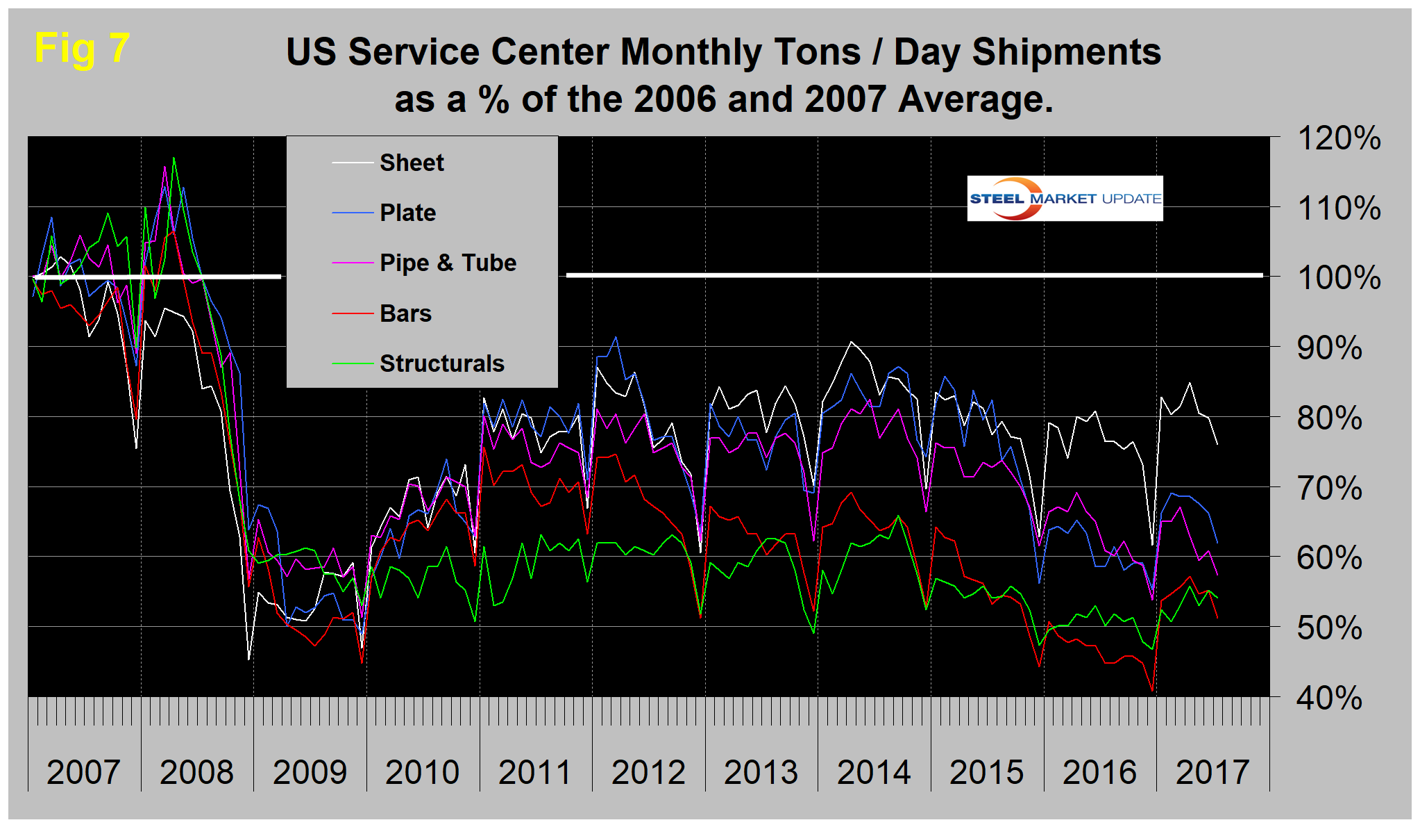
Each year, all products experience the December collapse and January pickup. In July, the total of carbon steel products was 66.2 percent of the shipping rate that existed in 2006 and 2007. Structurals and bar were 54.1 percent and 51.2 percent, respectively. Sheet was at 76.0 percent, plate at 61.9 percent and tubulars at 57.3 percent.
Inventories
March closed with months on hand (MoH) of 1.94 for all carbon steel products, which was the lowest level in 13 years (since July 2004). April increased to 2.28, May and June declined to 2.05 and 2.09, respectively, and July increased to 2.51 months. This calculation is misleading because it is based on total shipments for the month. Therefore, it is highly influenced by the number of shipping days. The March MoH was so low because shipping days were at the maximum. Compared to July last year, months on hand in total were down by 4.4 percent, led by pipe and tube, which were down by 11.2 percent. Sheet and plate were down by 6.6 percent and 2.6 percent, respectively. Long products had an increase in MoH year over year. There were the same number of shipping days in July 2016 and July 2017 at 20 days. Figure 8 shows the MoH by product monthly since July 2009.
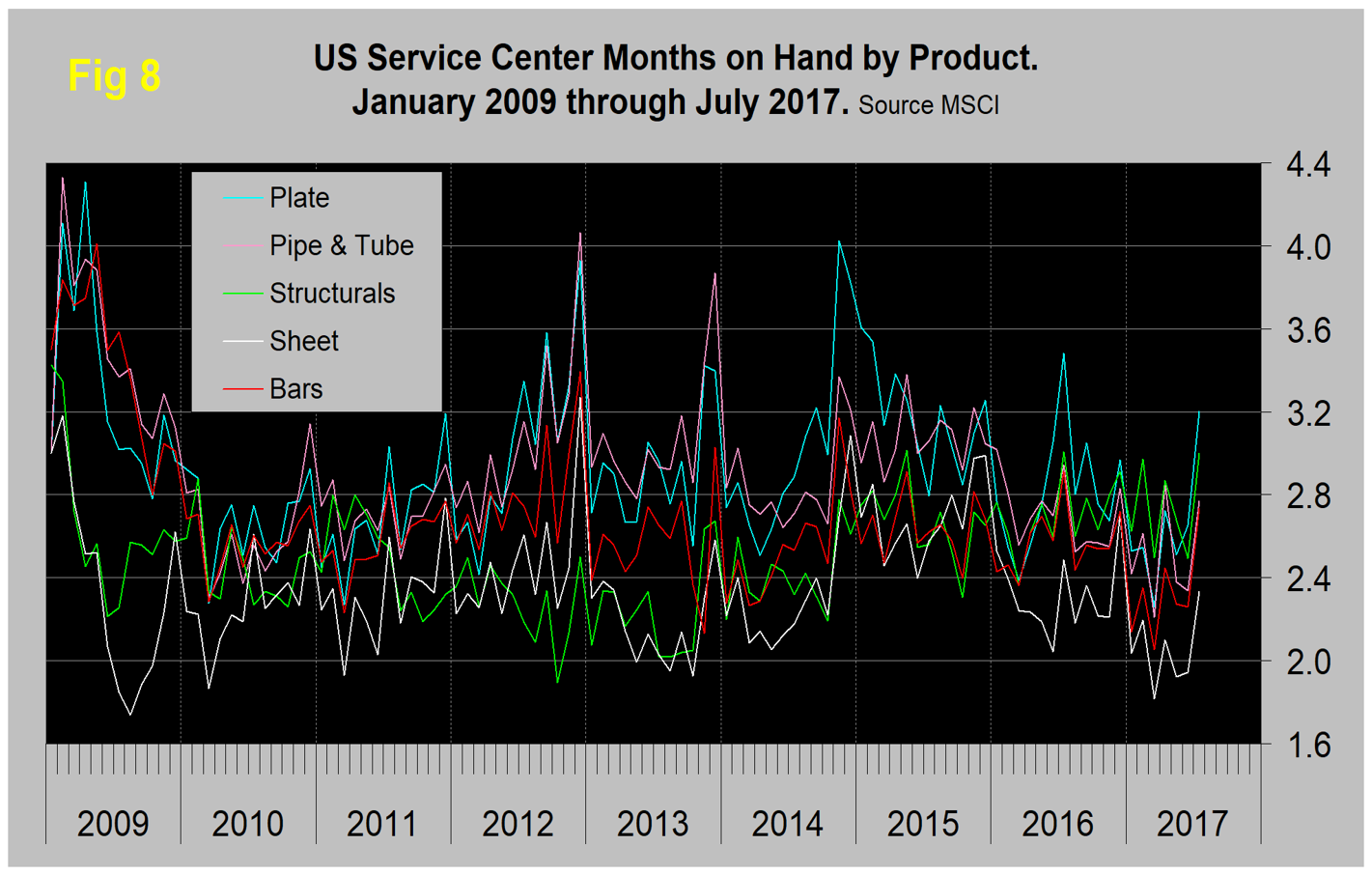
All products had a surge in months on hand in July, driven partly by a decrease in shipping days from 22 in June to 20 in July. Figure 9 shows both the month-end inventory and months on hand since July 2008 for total sheet products.
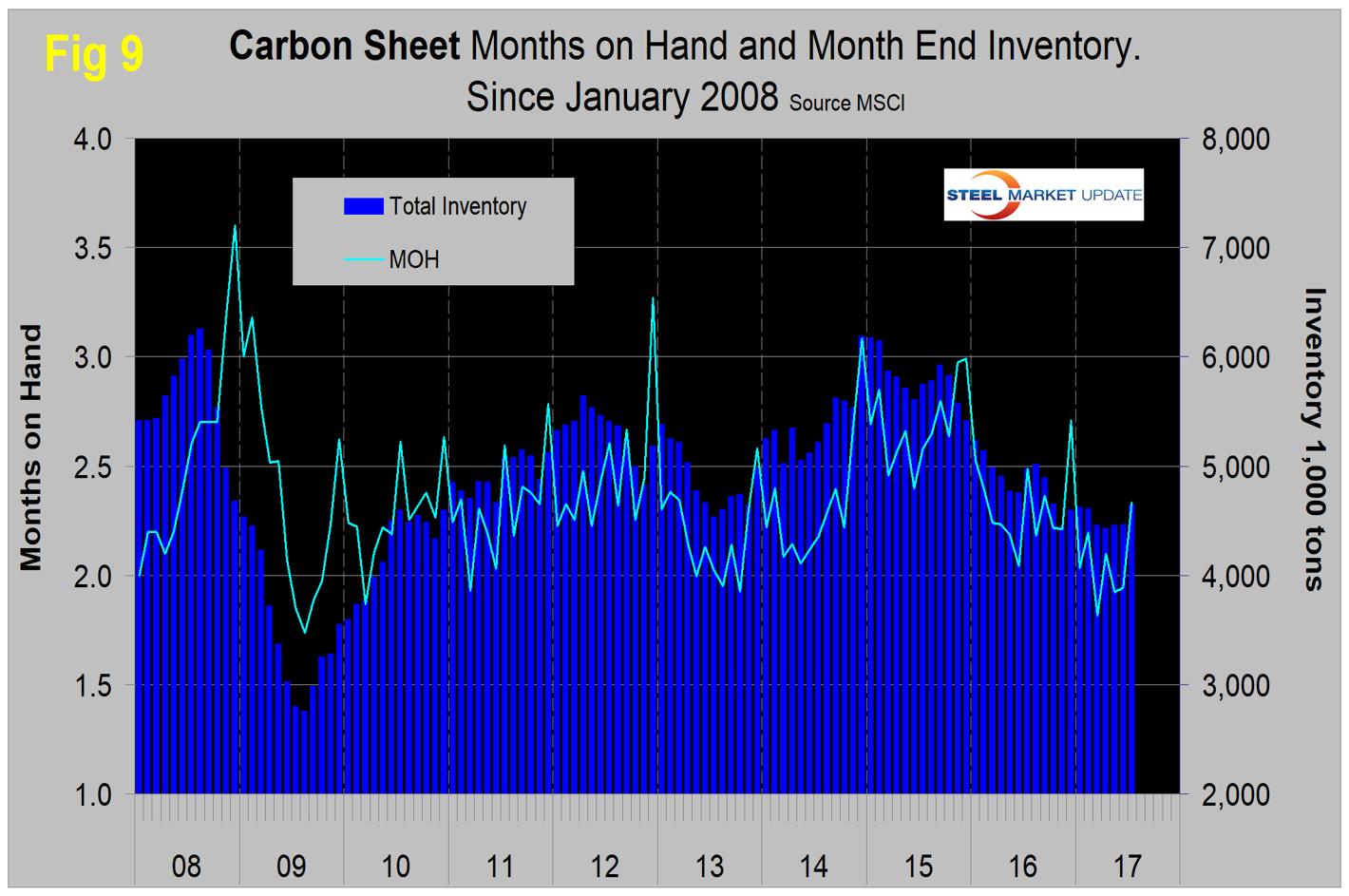
The total inventory tonnage of sheet products has been in decline since the end of 2014.
SMU Comment: In Figures 2, 3, 4, 5 and 6, the white lines show tons per day shipments. So far in 2017, the overall MSCI results have been improving, though less so in the last two months. However, there has been a big difference between products. Long products have enjoyed double-digit growth in the last four months, but at the other extreme tubulars have contracted every month for over two years. Sheet and plate have both had positive growth this year. These observations don’t jibe with our analysis of AISI and Commerce Department data. Figure 10 shows the total supply to the market of long and flat products based on AISI shipment and import data through June, which is the latest data available.
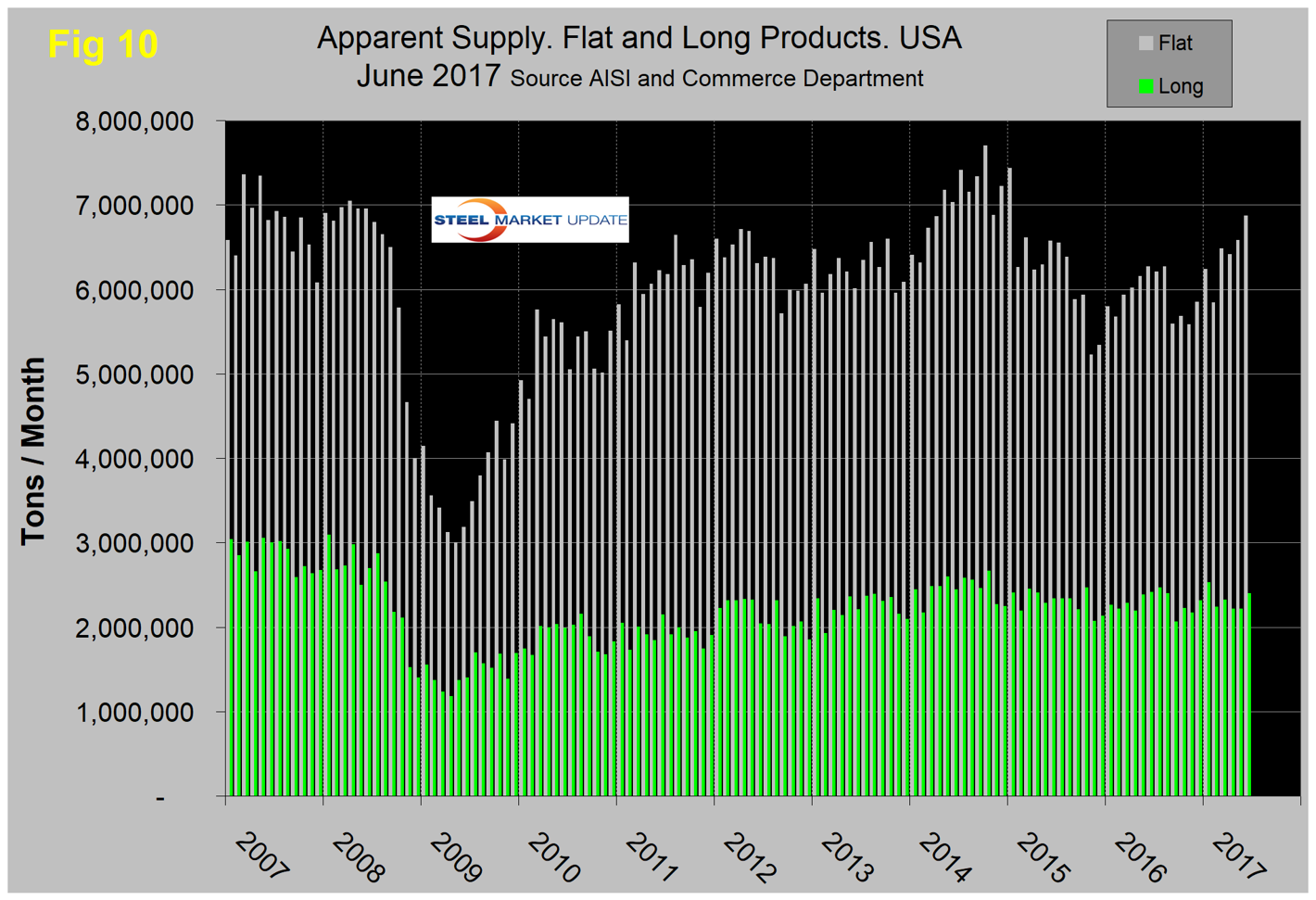
Total supply of long products has gone nowhere since mid-2014, in contrast to the recent double-digit growth at the service center level. Flat rolled products, on the other hand, have had very strong growth in total supply to the market for the last 12 months, but this has been muted for service centers.
The SMU data base contains many more product-specific charts than can be shown in this brief review. For each product, we have 10-year charts for shipments, intake, inventory tonnage and months on hand. Some readers have requested these extra charts for a particular product, and others are welcome to do so.







